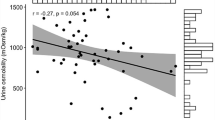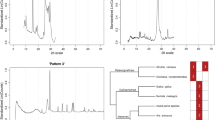Abstract
Red wattlebirds (Anthochaera carunculata) are among the more nectarivorous of the Australian honeyeaters (family Meliphagidae). As such, they potentially ingest large and dilute fluid loads as food, and they produce copious dilute urine in the field. We examined in the laboratory the renal mechanisms by which such fluid loads are processed. Wattlebirds received one of three liquid diets [a mix of honey, water, and Complan (Boots) complete dietary supplement] of varying concentration (250, 1000, and 1750 mmol/kg, Na+/K+ concentrations of 4/4, 12/15, and 23/30 mmol/l, respectively). We measured renal function via infusion of a filtration marker (14C-polyethylene glycol) from osmotic minipumps implanted intraperitoneally. Wattlebirds consumed volumes of the three diets sufficient to provide nearly equal caloric intakes (approximately 200 kJ/day), and as a consequence had water turnover rates varying from 30 to 200 ml/day (approximately 50–335% of total body water per day). Renal function in the morning, before feeding, did not differ among diet groups (glomerular filtration rate =18 ml/h, urine flow rate =0.4 ml/h). In the afternoon, after feeding, urine flow did vary, from 3 ml/h in birds on the most concentrated diet to 6 ml/h on the most dilute. This was accomplished by varying the rate of tubular reabsorption of water (from a high of >90% on the most concentrated diet to a low of just over 70% on the most dilute), with little variation in the rate of glomerular filtration (mean ∼23 ml/h). Comparisons between dietary intakes and urinary outputs of water and electrolytes suggest that not all dietary water was absorbed from the gut, but that there was significant post-renal reabsorption of Na+. The reduced fractional water reabsorption on the dilute diet was accompanied by a decrease in the circulating concentration of arginine vasotocin (from >4 pg/ml in birds on the two more concentrated diets to <1 pg/ml on the most dilute diet). In contrast, concentrations of aldosterone (10–20 pg/ml) did not differ among diets. Perhaps in consequence, renal fractional absorption of Na+ also did not differ, and so birds on the dilute diet, with their higher urine flows, had higher rates of Na+ excretion and suffered a decreased concentration of Na+ in the plasma.
Similar content being viewed by others
Author information
Authors and Affiliations
Additional information
Accepted: 14 January 1988
Rights and permissions
About this article
Cite this article
Goldstein, D., Bradshaw, S. Renal function in red wattlebirds in response to varying fluid intake. J Comp Physiol B 168, 265–272 (1998). https://doi.org/10.1007/s003600050145
Issue Date:
DOI: https://doi.org/10.1007/s003600050145




